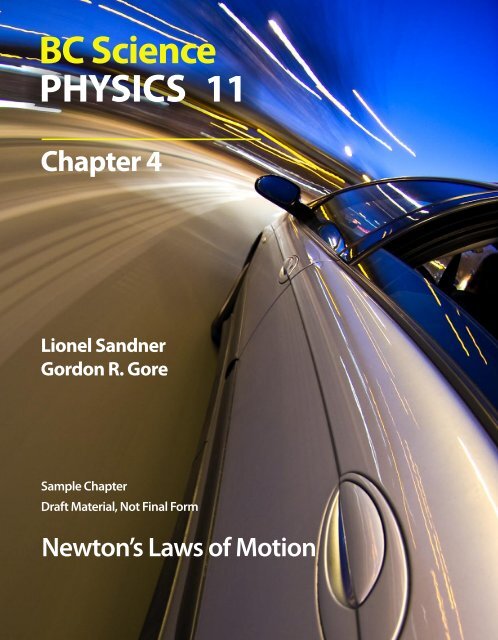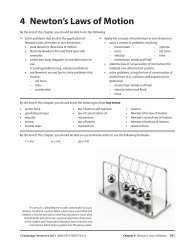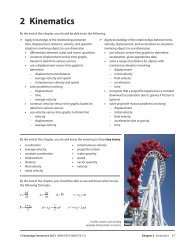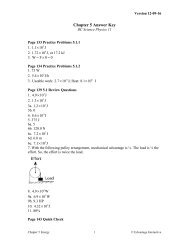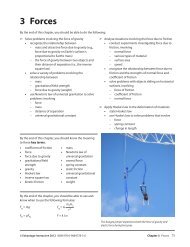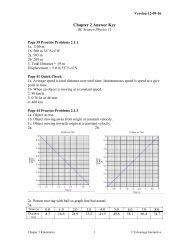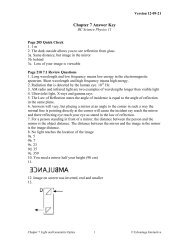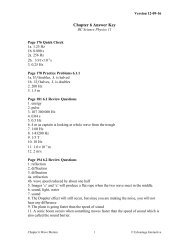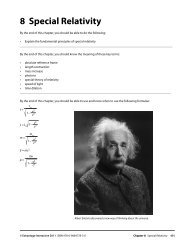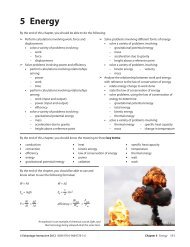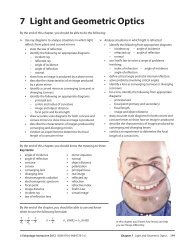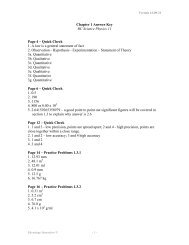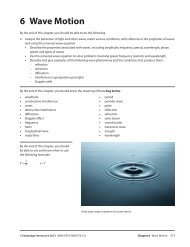Draft BCPhysics11-4 Edvantage Interactive.pdf - BC Science ...
Draft BCPhysics11-4 Edvantage Interactive.pdf - BC Science ...
Draft BCPhysics11-4 Edvantage Interactive.pdf - BC Science ...
You also want an ePaper? Increase the reach of your titles
YUMPU automatically turns print PDFs into web optimized ePapers that Google loves.
<strong>BC</strong> <strong>Science</strong><br />
PHYSICS 11<br />
Chapter 4<br />
Lionel Sandner<br />
Gordon R. Gore<br />
Sample Chapter<br />
<strong>Draft</strong> Material, Not Final Form<br />
Newton’s Laws of Motion
<strong>BC</strong> SCIENCE<br />
PHYSICS 11<br />
Authors<br />
Lionel Sandner<br />
<strong>Edvantage</strong> <strong>Interactive</strong><br />
Dr. Gordon R. Gore<br />
Director of Marketing: Don Franklin<br />
Director of Publishing: Yvonne Van Ruskenveld<br />
Design/Illustration/Production: Donna Lindenberg<br />
bcscienceinteractions.com
4 Newton’s Laws of Motion<br />
By the end of this chapter, you should be able to do the following:<br />
• Solve problems that involve application of Newton’s laws of motion in one dimension<br />
• Apply the concept of momentum in one dimension<br />
By the end of this chapter, you should know the meaning to these key terms:<br />
• action force<br />
• gravitational mass<br />
• impulse<br />
• inertia<br />
• inertial mass<br />
• law of action and reaction<br />
• law of conservation of momentum<br />
• law of inertia<br />
• momentum<br />
• Newton<br />
• Newton’s first law of motion<br />
• Newton’s second law of motion<br />
• Newton’s third law of motion<br />
• reaction force<br />
By the end of this chapter, you should be able to use and know when to use the following formulae:<br />
F = ma<br />
p = mv<br />
∆p = F∆t<br />
This device is called Newton’s cradle, named after Sir Isaac Newton, the British scientist. When a ball<br />
at one end is lifted and released, it hits the ball next to it but that ball doesn’t move. Only the ball at<br />
the end of the row is pushed upward as shown here. In this chapter you’ll learn about Newton’s laws<br />
of motion and momentum, which help to explain how this device works<br />
© <strong>Edvantage</strong> <strong>Interactive</strong> 2011 ISBN 978-0-9864778-3-6 Chapter 4 Newton’s Laws of Motion — DRAFT 161
4.1 Inertia and Newton’s First Law<br />
Warm Up<br />
You are attending a magic show and the magician stands beside a table set with fancy plates, cups and<br />
silverware. Grabbing the edge of the tablecloth she quickly pulls the cloth out, and the plates, cups and<br />
silverware stay in place. Is this magic or just physics in action? Explain your answer.<br />
______________________________________________________________________________________<br />
______________________________________________________________________________________<br />
______________________________________________________________________________________<br />
Inertia<br />
Imagine you are a passenger in a car, and the driver makes a sudden left turn. What<br />
sensation do you feel during the left turn? From your own experience, you might recall<br />
that you feel as if you are being pushed to the right. Contrary to what you feel, you are<br />
not being pushed to the right at all.<br />
����������<br />
������<br />
���<br />
����������������<br />
����<br />
���������<br />
162 Chapter 4 Newton’s Laws of Motion — DRAFT © <strong>Edvantage</strong> <strong>Interactive</strong> 2011 ISBN 978-0-9864778-3-6<br />
���<br />
Figure 4.1.1 As the car turns, your body wants to keep moving straight ahead.<br />
Figure 4.1.1 illustrates what happens and explains why you feel the force acting on<br />
your body. The car starts out by going straight and then the driver steers the car to the<br />
left. The car is moving to the left but your body wants to carry on in a straight line. What’s<br />
stopping you? The door of the car is moving left with the rest of the car so it is pushing<br />
you in the direction the car is going. You feel as if you are pushing against the door, but<br />
this feeling is not what is happening. What is happening is that your body is trying to<br />
continue along its original straight path while the car is turning left. The result is that you<br />
are being pulled along with the car rather than continuing in a straight line.
Measuring Inertia<br />
Quick Check<br />
As a general rule, any object tends to continue moving with whatever speed and<br />
direction it already has. This can include zero speed. When a driver accelerates a car, a<br />
body in the car tends to keep doing what it was already doing. So if the car is stopped,<br />
you are stopped. As the car starts to move and speeds up, you feel as if you are being<br />
pushed back into your seat.<br />
The tendency that all objects have to resist change in their states of motion is called<br />
inertia. Every object in the universe that has mass has this property of inertia. Galileo<br />
Galilei (1564–1642) was the first person to describe this property of nature, which is called<br />
the law of inertia.<br />
Some objects have more inertia than others because they have more mass. A<br />
logging truck has much more inertia than a mountain bike. Because it has so much more<br />
inertia, the logging truck is<br />
(a) more difficult to get moving<br />
(b) more difficult to stop<br />
(c) more difficult to turn at a corner<br />
Is there a way to measure inertia? You have measured it many times in science class. The<br />
way to measure inertia is to measure the object’s mass. When you measure the mass of an<br />
object using a balance, that mass is equal to the object’s inertial mass.<br />
Strictly speaking, what the balance measures is called gravitational mass. This<br />
is because the unknown object is placed on one pan, and a standard mass is placed on<br />
the other pan. The masses are assumed to be equal when the force of gravity on the<br />
unknown mass balances the force of gravity on the standard mass. Gravitational mass is<br />
numerically equal to inertial mass, so a balance can be used to measure inertial mass as<br />
well.<br />
1. Why does it hurt more to kick a rock shaped like a soccer ball than a soccer ball?<br />
_________________________________________________________________________________________<br />
_________________________________________________________________________________________<br />
2. When astronauts are living in the International Space Station (ISS) they are in orbit around Earth at a<br />
minimum altitude of 278 km. They live in an environment of apparent weightlessness. Compare the inertial<br />
mass of the astronauts when they live on the ISS and to their inertial mass when they are on Earth.<br />
_________________________________________________________________________________________<br />
_________________________________________________________________________________________<br />
Newton’s First Law<br />
Isaac Newton (1642–1727) is considered one of the greatest scientists of all time. In<br />
any physics class you ever take, you will come across his name at some time. This is<br />
impressive, given that all his work was done more than 350 years ago. Newton is probably<br />
best known for his laws of motion. Newton’s three laws describe motion as we experience<br />
it on Earth. They are also the foundation for helping to send humans to the Moon and<br />
deep-space vehicles out beyond our solar system.<br />
© <strong>Edvantage</strong> <strong>Interactive</strong> 2011 ISBN 978-0-9864778-3-6 Chapter 4 Newton’s Laws of Motion — DRAFT 163
Ideal Conditions<br />
Quick Check<br />
Newton’s first law of motion incorporated Galileo’s law of inertia. The first law of<br />
motion, or law of inertia, can be stated this way:<br />
A body will continue to move at the same speed and in the same direction for as<br />
long as there are no unbalanced forces acting on it.<br />
Put another way, an object wants to keep doing what it is already doing. This means if a<br />
basketball is placed on the floor, it will not move until another force acts on it. Someone<br />
picking up the ball is an example of a force acting on the ball.<br />
Sometimes it appears that Newton’s first law does not apply. For example, when<br />
coasting on your bicycle along a flat part of the road, you have probably noticed that you<br />
slow down even though it appears no forces are acting on the bicycle. In fact, the force<br />
of friction between the road and tires is responsible for slowing the bicycle. If there were<br />
no friction, the bicycle would continue at the same speed until another force acted on<br />
it. That is why in many physics problems about motion, you will see the assumption that<br />
there is no friction. A situation that is assumed to have no friction is called ideal conditions.<br />
Using ideal conditions, we can focus on the motion being observed. By specifying ideal<br />
conditions, we also show we know that friction would have to be considered under<br />
normal conditions.<br />
1. A car you are driving in encounters a patch of ice just as the car enters a corner turn. Using your knowledge<br />
of Newton’s first law of motion, explain what will happen to the car.<br />
2. You are a judge and listening to an injury claim from a bus passenger. The passenger claims to have been<br />
hurt when the bus driver slammed on the brakes and a suitcase came flying from the front of the bus to hit<br />
the passenger. Do you believe the passenger’s description of what happened? Explain your answer.<br />
3. When you receive a drink for a take out order, usually there is a lid on the cup. Use Newton’s first law to<br />
explain why the lid is necessary to prevent spills.<br />
164 Chapter 4 Newton’s Laws of Motion — DRAFT © <strong>Edvantage</strong> <strong>Interactive</strong> 2011 ISBN 978-0-9864778-3-6
Investigation 4-1 Investigating Inertia<br />
Purpose<br />
In this investigation, you and your teacher will do the problems shown below. Answering these problems will help<br />
you develop an understanding of inertia and Newton’s first law of motion.<br />
Problem 1: How does a seatbelt work?<br />
Photo to come<br />
Figure 4.1.2 Problem 1<br />
Procedure<br />
1. Place a small toy human figure on a toy car or truck as shown in Figure 4.1.2. Do not fasten the figure to the<br />
vehicle. Let the vehicle move toward an obstruction like another toy vehicle or a brick and collide with it.<br />
Observe what happens to the unattached passenger.<br />
2. Repeat step 1, but this time give the toy human figure a “seatbelt” by taping it to the vehicle.<br />
Questions<br />
1. How does this procedure illustrate inertia?<br />
2. How does a seatbelt work?<br />
3. Why are you more likely to survive a collision with a seatbelt than without one?<br />
Problem 2: Does air have inertia?<br />
Procedure<br />
1. Fill a large garbage bag with air, and hold it as shown in<br />
Figure 4.1.3.<br />
2. Quickly jerk the bag to one side. What happens to the air<br />
in the bag<br />
(a) when you start moving the bag?<br />
(b) when you stop moving the bag?<br />
Question<br />
1. What evidence have you observed from this procedure that<br />
supports the claim that air has inertia?<br />
Photo to come<br />
Figure 4.1.3 Problem 2<br />
© <strong>Edvantage</strong> <strong>Interactive</strong> 2011 ISBN 978-0-9864778-3-6 Chapter 4 Newton’s Laws of Motion — DRAFT 165
Problem 3: Inertia on an air track<br />
Procedure<br />
1. Place a glider on an air track as shown in Figure 4.1.4. Turn on the compressed air supply and check that<br />
the track is absolutely level. When the track is level the glider should have no tendency to move in one<br />
direction or the other. It should sit still.<br />
2. Place the glider at one end of the track. Give it a slight nudge, and let it go.<br />
3. Observe the motion of the glider.<br />
Questions<br />
1. Are there any unbalanced forces on the glider?<br />
2. Describe its motion.<br />
3. How does this demonstration illustrate Newton’s first law?<br />
���������<br />
Figure 4.1.4 Problem 3<br />
Problem 4: Get on the right track.<br />
Procedure<br />
1. Place a battery-powered toy train on a circular track, and let it run a few full circles.<br />
2. Predict which way the train will go if one of the sections of curved track is removed. Which one of the following<br />
will the train do? Explain your answer.<br />
(a) continue to move in a circle<br />
(b) move off along a radius of the circle<br />
(c) move off in a straight line tangent to the circle<br />
(d) follow some other path<br />
3. Now test your prediction by setting up a section of track as shown in Figure 4.1.5.<br />
Question<br />
1. What happens to the toy train when it leaves the track? Explain this in terms of inertia.<br />
Photo to come<br />
Figure 4.1.5 Problem 4<br />
������<br />
166 Chapter 4 Newton’s Laws of Motion — DRAFT © <strong>Edvantage</strong> <strong>Interactive</strong> 2011 ISBN 978-0-9864778-3-6
Problem 5: Where will the string break? Getting the “hang” of inertia<br />
Procedure<br />
1. Attach two equal masses, either 500 g or 1 kg, to a supporting<br />
rod, as shown in Figure 4.1.6. Use string that is strong enough to<br />
support the hanging masses, but not so strong that you cannot<br />
break it with a moderate pull with your hand. Add a 50 cm length<br />
of the same kind of string to the bottom of each mass.<br />
2. Predict where each string will break, above or below the mass, if<br />
you pull on the end of the string first gently and then abruptly. Test<br />
your predictions by experiment.<br />
Questions<br />
1. Explain what happened, in terms of inertia.<br />
2. Which action illustrates the weight of the ball and which<br />
illustrates the mass of the ball?<br />
Problem 6: The pop-up coaster<br />
(a) (b)<br />
Figure 4.1.7 Problem 6<br />
�����������������<br />
Figure 4.1.6 Problem 5<br />
Procedure<br />
1. The cart in Figure 4.1.7 contains a spring that can fire a steel ball straight up in the air. The cart is given a steady<br />
horizontal speed when pulled with a string. This also activates the trigger for the spring-loaded cannon. When<br />
the cart is moving with a steady speed, giving the string a sudden pull will release the spring and fire the ball up<br />
in the air.<br />
2. Predict whether the ball will land ahead of the cannon, behind the cannon, or in the cannon. Explain your<br />
prediction.<br />
3. Test your prediction.<br />
Questions<br />
1. What forces are acting on the ball when it is in the air?<br />
2. How does this procedure illustrate Newton’s first law of motion?<br />
3. Why does the ball sometimes miss the cart after it is released? Does this mean Newton’s first law sometimes<br />
does not apply?<br />
Concluding Question<br />
Use your understanding of inertia to explain the following situation: You are carrying a carton of milk with one hand<br />
and need to get a section of paper towel off the roll in your kitchen. You can only use one hand to tear off the paper<br />
towel. Why does a quick, jerking motion work better than a slow pulling motion when removing the paper towel<br />
section from the roll?<br />
© <strong>Edvantage</strong> <strong>Interactive</strong> 2011 ISBN 978-0-9864778-3-6 Chapter 4 Newton’s Laws of Motion — DRAFT 167
4.1 Review Questions<br />
1. In the Warm Up of this section, you were asked<br />
to explain why the magician was able to pull the<br />
tablecloth out from the under the plates, cups<br />
and silverware. Using the concepts of inertia and<br />
Newton’s first law, explain why this “magic act”<br />
succeeds.<br />
2. Does 2 kg of apples have twice the inertia or half the<br />
inertia of 1 kg of apples? Explain your answer.<br />
3. If the pen on your desk is at rest, can you say that no<br />
forces are acting on it? Explain your answer.<br />
4. If the forces acting on the pen are balanced, is it<br />
correct to say that the pen is at rest? Explain your<br />
answer.<br />
5. If you place a ball in the centre of a wagon and then<br />
quickly push the wagon forward, in what direction<br />
does the ball appear to go? Why?<br />
6. Why do headrests in cars help protect a person from<br />
head and neck injury in a car accident?<br />
7. A hockey puck moving a constant velocity across<br />
the ice eventually comes to a stop. Does this<br />
prove the Newton’s first law does not apply to all<br />
situations?<br />
8. You are travelling in a school bus on a field trip. The<br />
driver has to apply the brakes quickly to prevent an<br />
accident. Describe how your body would move in<br />
response to this rapid braking action.<br />
9. While travelling in Africa you are chased by a very<br />
large elephant. Would it make more sense to run<br />
in a straight line to get away or in a zigzag motion?<br />
Explain your answer.<br />
168 Chapter 4 Newton’s Laws of Motion — DRAFT © <strong>Edvantage</strong> <strong>Interactive</strong> 2011 ISBN 978-0-9864778-3-6
4.2 Newton’s Second Law of Motion<br />
Warm Up<br />
Take an empty spool of thread and wrap a string or thread around it three<br />
or four times, as shown in the photo. Place the spool on the floor and pull<br />
on the thread horizontally to make the spool move to the right.<br />
1. Based on your observations, what can you say about the direction of<br />
the force applied to the spool and the acceleration of the spool?<br />
_________________________________________________________________________________________<br />
_________________________________________________________________________________________<br />
2. Does it matter if the thread is wrapped around the spool in the opposite direction? Explain your answer.<br />
_________________________________________________________________________________________<br />
_________________________________________________________________________________________<br />
Defining Newton’s<br />
Second Law of<br />
Motion<br />
In his second law of motion, Newton dealt with the problem of what happens when<br />
an unbalanced force acts on a body. Newton’s second law of motion states: If an<br />
unbalanced force acts on a body, the body will accelerate. The rate at which it accelerates<br />
depends directly on the unbalanced force and inversely on the mass of the body.<br />
F = ma<br />
The direction in which the body accelerates will be the same direction as the<br />
unbalanced force. The measuring unit for force is the newton (N). The measuring unit<br />
for mass is the kilogram (kg) and for acceleration is m/s 2 . Therefore, using F = ma, one<br />
newton can be defined as the force needed to accelerate one kilogram at a rate of one<br />
metre per second per second.<br />
Whenever Newton’s second law is used, it is understood that the force F in the<br />
equation F = ma is the unbalanced force acting on the body. This unbalanced force is also<br />
called the net force. To calculate the unbalanced force acting on a 1.0 kg mass falling due<br />
to gravity, you use Newton’s second law:<br />
F = ma = 1.0 kg × 9.8 m/s 2 = 9.80 kg•m/s 2 = 9.80 N<br />
To calculate the rate at which the mass accelerates, you rearrange Newton’s second<br />
law to give:<br />
a = F<br />
m<br />
= 9.90 N<br />
1.0 kg<br />
= 9.8 kg•m/s2<br />
1.0 kg<br />
= 9.80 m/s 2<br />
The acceleration of the mass is g or 9.80 m/s 2 .<br />
© <strong>Edvantage</strong> <strong>Interactive</strong> 2011 ISBN 978-0-9864778-3-6 Chapter 4 Newton’s Laws of Motion — DRAFT 169
Quick Check<br />
1. A single engine plane has a mass of 1500 kg and acceleration of 0.4 m/s 2 . What is the thrust, or unbalanced<br />
force, from the engine?<br />
2. What is the mass of a rocket that accelerates at 2.0 m/s 2 and has a thrust of 25 000 N?<br />
3. Find the acceleration of a passenger jet that has a mass of 250 000 kg and a total engine thrust of 50 000 N.<br />
Multiple Forces<br />
The example and problems in the Quick Check above involve only one unbalanced force.<br />
In other situations, like Sample Problem 4.2.1 below, there are more forces to consider.<br />
Remember that, in these problems, it is important to identify the forces that<br />
create the unbalanced force. Figure 4.2.1 shows four different forces acting on a block.<br />
The two vertical forces are the force of gravity and the normal force (the force exerted by<br />
the floor on the block). The two horizontal forces are the applied force and the force of<br />
friction.<br />
The two vertical forces balance each other because the force of gravity and the<br />
normal force equal each other in size and act in opposite directions. The unbalanced force<br />
is the difference between the applied force and the friction force opposing the applied<br />
force.<br />
170 Chapter 4 Newton’s Laws of Motion — DRAFT © <strong>Edvantage</strong> <strong>Interactive</strong> 2011 ISBN 978-0-9864778-3-6
Sample Problem 4.2.1 — Multiple Forces Acting on a Body<br />
A 45.0 N block is being pushed along a floor, where the coefficient of kinetic friction is 0.333. If a force of 25.0 N is<br />
applied, at what rate will the block accelerate? The mass of the block is 4.60 kg.<br />
�������������<br />
��<br />
��<br />
Figure 4.2.1 Forces acting on block<br />
What to think about<br />
1. Find the force of friction.<br />
2. Find the unbalanced force.<br />
�<br />
3. Find the acceleration.<br />
������������<br />
��<br />
����������������<br />
�������������<br />
������������������������������<br />
������������������������������<br />
��������������<br />
How to Do It<br />
F f = µF n = µF g = (0.333) × (45.0 N) = 15.0 N<br />
unbalanced force = applied force – friction force<br />
F = 25.0 N – 15.0 N = 10.0 N<br />
a = F =<br />
10.0 N<br />
m 4.60 kg<br />
= 2.17 m/s2<br />
© <strong>Edvantage</strong> <strong>Interactive</strong> 2011 ISBN 978-0-9864778-3-6 Chapter 4 Newton’s Laws of Motion — DRAFT 171
Practice Problems 4.2.1 — Multiple Forces Acting on a Body<br />
1. A falling object of 20 N experiences air resistance of 6.0 N. If acceleration due to gravity is 9.8 m/s 2 , what is the<br />
mass of the object?<br />
2. A 900 N person stands on two scales so that one foot is on each scale. What will each scale register in<br />
Newtons?<br />
3. What is the mass of a paratrooper who experiences an air resistance of 400 N and an acceleration of 4.5 m/s 2<br />
during a parachute jump.<br />
4. A force of 50 N accelerates a 5.0 kg block at 6.0 m/s 2 along a horizontal surface.<br />
(a) What is the frictional force acting on the block?<br />
(b) What is the coefficient of friction?<br />
172 Chapter 4 Newton’s Laws of Motion — DRAFT © <strong>Edvantage</strong> <strong>Interactive</strong> 2011 ISBN 978-0-9864778-3-6
Investigation 4-2 Newton’s Second Law of Motion<br />
Purpose<br />
To investigate how the change in speed of a cart is affected by<br />
(a) the amount of unbalanced force, and (b) the amount of mass in the cart<br />
Procedure<br />
Part 1: Setting up and moving the cart<br />
1. Set up the apparatus as shown in Figure 4.2.2(a). Suspend a mass of 200 g from the end of a string, which passes<br />
over a pulley at the end of the bench. The force of gravity on this mass is 1.96 N or approximately 2.0 N.<br />
2. Lift one end of your laboratory table so that the cart rolls toward the pulley at a steady speed. This can be<br />
checked with a ticker tape and your recording timer. If your bench cannot be lifted, do the experiment on a<br />
length of board, which can be raised at one end. What this lifting does is balance friction with a little help from<br />
gravity.<br />
3. The class will now share the task of preparing and analyzing ticker-tape records of speed vs. time for each of<br />
the situations in Figure 4.2.2. Each lab group of two students will choose one of the eight set-ups and prepare<br />
two tapes or one for each partner. Note that the whole system of cart-plus-string-plus-hanging-mass moves as<br />
one unit. The mass of the whole system must be kept constant. This means that once you build your system you<br />
must not add any additional masses.<br />
Varying the Unbalanced Force Varying the Mass<br />
��������������<br />
��������������<br />
��������������<br />
��������������<br />
��������������<br />
������������������<br />
������������������<br />
������������������<br />
������������������<br />
Figure 4.2.2 Cart and mass set-ups<br />
��������������<br />
��������������<br />
��������������<br />
������������������<br />
� �������������<br />
������������������<br />
� ��������������<br />
������������������<br />
� ��������������<br />
������������������<br />
� ��������������<br />
© <strong>Edvantage</strong> <strong>Interactive</strong> 2011 ISBN 978-0-9864778-3-6 Chapter 4 Newton’s Laws of Motion — DRAFT 173
Part 2: Preparing Your Own Tape<br />
1. The class as a team will prepare and analyze tapes for each of the situations in Figure 4.2.2. If your class is large<br />
enough, compare duplicated data for any potential sources of error.<br />
2. Use the technique you used to measure acceleration in an earlier chapter. Remember that a group of six dots<br />
represents 0.10 s and that the average speeds for each interval are plotted mid-way through each time interval<br />
and not at the end of the interval.<br />
3. Prepare your graph. Label it carefully with the unbalanced force used (2.0 N, 4.0 N, 6.0 N, or 8.0 N) and the mass<br />
of the cart system.<br />
4. The most important measurement you need is the acceleration of the cart. You get this from the slope of the<br />
graph. Express the acceleration in cm/s 2 . You will share this information with the rest of the class.<br />
Part 3: Analyzing Class Data<br />
1. Prepare the following tables of data, summarizing class results.<br />
Table 4.2.1 Acceleration vs. Unbalanced Force<br />
(mass constant)<br />
Unbalanced Force<br />
F (N)<br />
2.0<br />
4.0<br />
6.0<br />
8.0<br />
Acceleration<br />
a (cm/s 2 )<br />
0 0<br />
Table 4.2.2 Acceleration vs Mass (unbalanced force constant)<br />
Mass, m<br />
(mass units)<br />
2. Plot a graph of acceleration (y-axis) against unbalanced force (x-axis).<br />
3. Plot a graph of acceleration against mass.<br />
4. Plot a graph of acceleration against the reciprocal of mass (1/m).<br />
Acceleration, a<br />
(cm/s 2 )<br />
1<br />
mass ,<br />
174 Chapter 4 Newton’s Laws of Motion — DRAFT © <strong>Edvantage</strong> <strong>Interactive</strong> 2011 ISBN 978-0-9864778-3-6<br />
1<br />
m<br />
(mass units –1 )<br />
1.0 1.0<br />
2.0 0.50<br />
3.0 0.33<br />
4.0 0.25<br />
Concluding Questions<br />
1. Describe how the speed of a cart changes when a constant unbalanced force pulls it.<br />
2. According to your first graph (a vs. F), how does acceleration depend on unbalanced force? Does your graph<br />
suggest that acceleration is directly proportional to unbalanced force? Support your answer with your data.<br />
3 According to your second and third graphs, how does the acceleration of the cart vary when the mass is<br />
doubled, tripled, and quadrupled?<br />
4 Write an equation for the third graph, complete with the numerical value and units for the slope.<br />
5 What were some of the experimental difficulties you encountered in this investigation, which would make it<br />
difficult to obtain ideal results?
4.2 Review Questions<br />
1. What unbalanced force is needed to accelerate a<br />
5.0 kg cart at 5.0 m/s 2 ?<br />
2. A net force of 7.5 × 10 4 N acts on a spacecraft of<br />
mass 3.0 × 10 4 kg.<br />
(a) At what rate will the spacecraft accelerate?<br />
(b) Assuming constant acceleration is maintained,<br />
how fast will the spacecraft be moving after 25 s,<br />
if its initial speed was 5.0 × 10 3 m/s?<br />
3. A model rocket has a mass of 0.12 kg. It accelerates<br />
vertically to 60.0 m/s in 1.2 s.<br />
(a) What is its average acceleration?<br />
(b) What is the unbalanced force on the rocket?<br />
(c) If the force of gravity on the rocket is 1.2 N,<br />
what is the total thrust of its engine?<br />
4. What is the mass of a rock if a force of 2.4 × 10 3 N<br />
makes it accelerate at a rate of 4.0 × 10 1 m/s 2 ?<br />
5. A fully loaded military rocket has a mass of<br />
3.0 × 10 6 kg, and the force of gravity on it at ground<br />
level is 2.9 × 10 7 N.<br />
(a) At what rate will the rocket accelerate during<br />
lift-off, if the engines provide a thrust of<br />
3.3 × 10 7 N?<br />
(b) Why will this acceleration not remain constant?<br />
6. A boy and his skateboard have a combined mass of<br />
60.0 kg. After an initial shove, the boy starts coasting<br />
at 5.5 m/s along a level driveway. Friction brings<br />
him to rest in 5.0 s. The combined force of gravity on<br />
the boy and skateboard is 5.9 × 10 2 N. What is the<br />
average coefficient of rolling friction between the<br />
driveway and the skateboard wheels?<br />
© <strong>Edvantage</strong> <strong>Interactive</strong> 2011 ISBN 978-0-9864778-3-6 Chapter 4 Newton’s Laws of Motion — DRAFT 175
4.3 Newton’s Third Law of Motion<br />
Warm Up<br />
1. Consider the following situations. Draw a sketch of each situation and, on each diagram, indicate the forces<br />
being described. Share your results with the class.<br />
(a) If you wish to climb stairs, in which (c) If you are rowing a boat, which way must your<br />
direction do you push? Which way to you oars push if the boat is to move forward? Which<br />
move? way to do you move?<br />
(b) If you wish to swim forward, in which (d) When a car is moving forward, in which<br />
direction must your arms push? Which direction do the wheels push on the road? Which<br />
way do you move? way to do you move?<br />
Action and Reaction<br />
Forces<br />
Isaac Newton observed that whenever forces exist between two bodies, the forces are<br />
mutual. If one body pushes on another, the other body exerts an equal force on the first<br />
body, but in the opposite direction. To do push-ups, for example, you push down on the<br />
floor. The floor exerts an equal force up on you. The floor lifts you up! Earth exerts a force<br />
of gravity on the Moon. What evidence is there that the Moon exerts an equal force on<br />
Earth?<br />
Newton studied situations involving forces between pairs of bodies and he stated<br />
his conclusions about mutual forces between pairs of bodies as his third law. Newton’s<br />
third law of motion is also called the law of action and reaction.<br />
If two bodies interact, the force the first body exerts on the second body will equal<br />
the force the second body exerts on the first body. The two forces will be opposite in<br />
direction and will act simultaneously over the same interval of time.<br />
176 Chapter 4 Newton’s Laws of Motion — DRAFT © <strong>Edvantage</strong> <strong>Interactive</strong> 2011 ISBN 978-0-9864778-3-6
Quick Check<br />
The first force is called the action force, and the second force is called the reaction<br />
force. If we call the first body A and the second body B, then the law of action and<br />
reaction can be expressed mathematically like this:<br />
FA on B = – FB on A<br />
where the minus sign indicates opposite direction.<br />
It is important to remember that for both forces, each force is exerted on the<br />
other body. The forces do not cancel. This is a really important point. For example,<br />
imagine a horse pulling a cart. If we just consider the force the horse exerts on the cart,<br />
then Newton’s third law tells us that the cart exerts an equal and opposite force on the<br />
horse. The two forces are illustrated in Figure 4.3.1.<br />
� ������<br />
�� ������<br />
Figure 4.3.1 The horse and the cart are exerting equal and opposite forces on each other.<br />
You might look at the picture and say that the horse and cart do not move<br />
because the two forces seem to cancel each other out. They are equal and opposite. But<br />
remember that the horse is exerting an action force on the cart and the cart is exerting a<br />
reaction force on the horse. That is why the horse feels the heavy cart on its harness when<br />
it starts pulling.<br />
When applying Newton’s third law, always ask yourself what object or thing<br />
applies the force and what body or object receives the force. There must be two different<br />
bodies or objects.<br />
1. Review your diagrams from the Warm Up activity. In each diagram, label the action force and reaction force.<br />
2. When you are walking, you are producing an action force toward the ground. Why do you move in the<br />
opposite direction?<br />
_________________________________________________________________________________________<br />
_________________________________________________________________________________________<br />
3. You see a large dog running along a floating log. If the dog is running to your right, what, if anything, is<br />
happening to the log?<br />
_________________________________________________________________________________________<br />
_________________________________________________________________________________________<br />
© <strong>Edvantage</strong> <strong>Interactive</strong> 2011 ISBN 978-0-9864778-3-6 Chapter 4 Newton’s Laws of Motion — DRAFT 177
Investigation 4-3 Newton’s Third Law<br />
Purpose<br />
To observe demonstrations of Newton’s third law and identify the action and reaction forces<br />
Procedure<br />
Part 1: Exploding Carts<br />
Figure 4.3.2 Laboratory carts<br />
1. Push two identical laboratory carts together so that their spring bumpers are compressed. Release the carts on<br />
a flat table or floor. Observe as they accelerate away from each other.<br />
(a) What force makes the carts accelerate?<br />
(b) Why do the two carts, of identical mass, accelerate at the same rate?<br />
(c) How does this demonstration illustrate Newton’s third law?<br />
2. Predict what will happen if you double the mass of one of the carts by placing an extra cart on top of it. Test<br />
your prediction.<br />
(a) Has the force repelling the carts changed?<br />
(b) What has changed?<br />
3. Try making the mass of one of the carts much greater than the mass of the other.<br />
(a) Is the force changed?<br />
(b) What has changed?<br />
178 Chapter 4 Newton’s Laws of Motion — DRAFT © <strong>Edvantage</strong> <strong>Interactive</strong> 2011 ISBN 978-0-9864778-3-6
Part 2: Motion from Rest<br />
Photo to come<br />
Figure 4.3.3 Set-up for part 2<br />
1. Place a piece of light plastic insulating Styrofoam board (50 cm × 25 cm × 2.5 cm) at one end of an air table as<br />
shown in Figure 4.3.3. Place a wind-up toy car or a radio-controlled car at one end of the board. Turn on the air<br />
table and start the car moving. Observe and describe what happens:<br />
(a) to the car<br />
(b) to the “road” under the car<br />
2. How does this demonstration illustrate Newton’s Third Law?<br />
Part 3: Tug of War<br />
Figure 4.3.4 Students stretching the string<br />
1. Tie a string between two 20 N spring balances. Have two students stretch the string between them as shown in<br />
Figure 4.3.4. What do the two spring balances read?<br />
2. Try pulling with different forces. Compare the forces on each spring balance each time you pull on the string<br />
with a different force. Does it matter who does the pulling?<br />
3. Try adding a third spring balance in the middle of the string. How does this demonstration illustrate Newton’s<br />
third law?<br />
Concluding Questions<br />
1. When a car moves forward, in which direction do the wheels of the car push on the road? What force actually<br />
makes the car move forward?<br />
2. List and discuss three examples of situations from your own everyday experience, that involve Newton’s third<br />
law.<br />
© <strong>Edvantage</strong> <strong>Interactive</strong> 2011 ISBN 978-0-9864778-3-6 Chapter 4 Newton’s Laws of Motion — DRAFT 179
4.3 Review Questions<br />
1. You are playing softball and your friend throws a<br />
ball to you. You catch the ball. The action force is the<br />
impact of the ball against your glove. What is the<br />
reaction force?<br />
2. During a golf swing, is the club impacting on the<br />
ball the action force or the reaction force? Use a<br />
diagram to illustrate your answer.<br />
3. If a soccer player kicks a ball with a force of 100 N,<br />
what is the magnitude of the reaction force?<br />
4. Spiderman is having a tug of war with a grade 2<br />
student. Both are pulling very hard from opposite<br />
ends. Who exerts a greater force on the rope?<br />
Explain your answer.<br />
5. In a demolition derby a Hummer SUV collides<br />
head-on with a SMART car. Which car experiences a<br />
greater impact force? Explain your answer.<br />
6. During a martial arts demonstration, a black belt<br />
uses a karate chop to break a large board with her<br />
hand by exerting a force of 2000 N. What force did<br />
the board exert on her hand?<br />
7. A few years from now after much hard work, you are<br />
an astronaut and are completing a repair of some<br />
solar panels. To do this you have to take space walk<br />
outside the International Space Station. By accident,<br />
you find yourself disconnected from the support<br />
rope and need to get back to the station. All you<br />
have is your tools with you. How can you propel<br />
yourself back to safety?<br />
180 Chapter 4 Newton’s Laws of Motion — DRAFT © <strong>Edvantage</strong> <strong>Interactive</strong> 2011 ISBN 978-0-9864778-3-6
4.4 Momentum<br />
Warm Up<br />
Consider the following objects and motion in the two columns below:<br />
feather fast (10 m/s)<br />
marble average (5 m/s)<br />
softball slow (2 m/s)<br />
1. Connect an object in the first column with a motion in the second column for the following situations.<br />
(a) The combination that will cause the most pain if the object hits your leg<br />
_________________________ + __________________________<br />
(b) The combination that will cause the least pain if the object hits your leg<br />
_________________________ + __________________________<br />
2. Explain your reasoning for each answer.<br />
(a) __________________________________________________________________________________<br />
_____________________________________________________________________________________<br />
(b) __________________________________________________________________________________<br />
_____________________________________________________________________________________<br />
Mass × Velocity =<br />
Momentum<br />
One of the most important concepts in physics is that of momentum. Isaac Newton first<br />
used the idea when he wrote his second law of motion. In his original version, the second<br />
law looks like this:<br />
F = m∆v<br />
t<br />
Newton called the product of mass and velocity (mv) a quantity of motion. Thus, his<br />
second law stated that the unbalanced force on an object is equal to the rate of change<br />
of a quantity of motion with respect to time. We now call the product of mass × velocity<br />
momentum and we give it the symbol p. The unit of measurement for momentum is<br />
kg•m/s.<br />
p = m∆v<br />
Newton’s second law can be written this way:<br />
F = ma = m∆v<br />
t<br />
∆p<br />
=<br />
t<br />
Thus, the unbalanced force equals the rate of change of momentum with respect to time.<br />
© <strong>Edvantage</strong> <strong>Interactive</strong> 2011 ISBN 978-0-9864778-3-6 Chapter 4 Newton’s Laws of Motion — DRAFT 181
Quick Check<br />
1. What is the momentum of a 100 kg motorbike travelling at 10 m/s?<br />
2. What is the mass of plane that is travelling at 200 km/h and has a momentum of 1.1 × 10 6 kg•m/s?<br />
3. How fast does a 0.01 kg bug have to fly to have a momentum of 0.25 kg•m/s? Is this possible?<br />
Impulse<br />
According to Newton’s second law, in its original form F = mv<br />
t<br />
∆p = F∆t = m∆v<br />
. This can be rearranged to:<br />
The product of the force and the time interval during which it acts is called the<br />
impulse. It is given the symbol I. The last equation shows that the impulse is equal to the<br />
change in momentum it produces.<br />
This is an important relationship when considering an object that is undergoing a<br />
change in momentum. An object’s momentum changes because an impulse has been<br />
placed on the object. For example, if you are driving down a road at a constant velocity,<br />
you and your vehicle have a momentum. When you press on the gas pedal, the velocity<br />
of the vehicle increases. The momentum has also increased. This increased momentum<br />
was caused by a force being exerted on the vehicle over a period of time. Or put another<br />
way, the vehicle experienced an impulse. The amount of impulse equals the change in<br />
momentum in the vehicle.<br />
Units for Momentum and Impulse<br />
Momentum is measured in kg•m/s because these units have the dimensions of mass and<br />
velocity. Impulse is measured in N•s because these units have the dimensions of force and<br />
time. Since impulse is equal to change in momentum, these units must be equivalent. It<br />
can easily be shown that this is true:<br />
[N•s] = [kg•m/s 2 ] • [s] = [kg•m/s]<br />
Momentum and impulse may be expressed in either unit.<br />
182 Chapter 4 Newton’s Laws of Motion — DRAFT © <strong>Edvantage</strong> <strong>Interactive</strong> 2011 ISBN 978-0-9864778-3-6
Quick Check<br />
1. (a) What is the momentum of a 112 kg football player running with a velocity of 3.6 m/s?<br />
(b) What impulse must a tackler impart to the football player to bring him to a stop?<br />
(c) If the tackle was completed in 0.80 s, what average force did the tackler exert on the other player?<br />
(d) Why is the force negative in question 1c?<br />
____________________________________________________________________________________<br />
____________________________________________________________________________________<br />
Law of Conservation<br />
of Momentum<br />
Any moving body has momentum equal to the product of the body’s mass and its<br />
velocity. What makes momentum such an important quantity in nature is the fact that in<br />
a closed system, momentum is conserved. A closed system is one where no outside forces<br />
act on the system. This is the law of conservation of momentum. In other words, the<br />
total change in momentum within the closed, two-body system is zero. This means that<br />
the total momentum is constant, or that momentum is conserved.<br />
Scientists have done many, many experiments with momentum and are convinced<br />
that momentum truly is a conserved quantity in nature. At the subatomic level in<br />
experiments done with high-energy particle accelerators, physicists rely heavily on the<br />
law of conservation of momentum in interpreting the results of collisions of particles.<br />
Conservation of Momentum and Newton’s Third Law<br />
Newton’s third law is a special case of the law of conservation of momentum. This can be<br />
shown by using a proof. A proof is a mathematical solution that logically demonstrates<br />
something to be true. The following is a proof showing that Newton’s third law is a special<br />
case of the law of conservation of momentum.<br />
Consider two bodies interacting such that body A exerts a force on body B, and<br />
body B exerts an equal force on body A, but in the opposite direction.<br />
F = – F<br />
A on B B on A<br />
action force = – reaction force<br />
The minus sign indicates that the direction of the reaction force is opposite to that<br />
of the action force. Using Newton’s second law, written in terms of momentum:<br />
© <strong>Edvantage</strong> <strong>Interactive</strong> 2011 ISBN 978-0-9864778-3-6 Chapter 4 Newton’s Laws of Motion — DRAFT 183<br />
m B v B<br />
t<br />
= m A v A<br />
t
The time intervals on both sides of the equation are the same because both forces<br />
act over the same interval of time. So the equation can be simplified to:<br />
m B v B = – m A v A<br />
Therefore, m A v A + m B v B = 0<br />
or p A + p B = 0<br />
Other Examples of the Law of Conservation of Momentum<br />
If you have ever played pool or billiards you will be familiar with the law of conservation<br />
of momentum. When the cue ball, or white ball, hits another ball, momentum is<br />
conserved. For example, if all the momentum is transferred from the cue ball to the<br />
billiard ball, the cue ball will stop and the billiard ball will move.<br />
Sample Problem 4.4.1 — Conservation of Momentum<br />
A railway car of mass 6.0 × 10 3 kg is coasting along a track with a velocity of 5.5 m/s when suddenly a 3.0 × 10 3 kg<br />
load of sulphur is dumped into the car. What is its new velocity?<br />
What to think about<br />
1. What do I know about the problem?<br />
2. What am I trying to solve?<br />
3. What formula applies to this situation?<br />
4. Find the final velocity v 2 .<br />
How to Do It<br />
The momentum of the railway car will not change<br />
because of the law of conservation of momentum.<br />
Let initial mass be m 1 and initial velocity be v 1 .<br />
The final mass of the railway car will be m 2 and the<br />
final velocity v 2 .<br />
Solve for the final velocity v 2 .<br />
m 1 v 1 = m 2 v 2<br />
(6.0 × 103 kg)(5.5 m/s) = (6.0 × 103 kg +<br />
3.0 × 103 kg)(v2 )<br />
33 × 103 kg•m/s = (9.0 × 103 kg)(v2 )<br />
v2 = 33 103 kg•m/s<br />
9.0 103 kg<br />
184 Chapter 4 Newton’s Laws of Motion — DRAFT © <strong>Edvantage</strong> <strong>Interactive</strong> 2011 ISBN 978-0-9864778-3-6
Practice Problems 4.4.1 — Conservation of Momentum<br />
1. Two identical air track gliders each have a mass of 100 g and are sitting on an air track. One glider is at rest<br />
and the other glider is moving toward it at a velocity. When they collide they stick together and move off at<br />
2.0 m/s. What was the initial velocity of the moving glider?<br />
2. A 1.0 kg ball of putty is rolling towards a resting 4.5 kg bowling ball at 1.5 m/s. When they collide and stick<br />
together, what is the resulting momentum of the two objects stuck together?<br />
3. A ball rolls at a velocity of 3.5 m/s toward a 5.0 kg ball at rest. They collide and move off at a velocity of 2.5 m/s.<br />
What was the mass of the moving ball?<br />
© <strong>Edvantage</strong> <strong>Interactive</strong> 2011 ISBN 978-0-9864778-3-6 Chapter 4 Newton’s Laws of Motion — DRAFT 185
4.4 Review Questions<br />
1. What is the momentum of a 75 g mouse running<br />
across the floor with a velocity of 2.6 m/s?<br />
2. What is the impulse of a 55 N force exerted over a<br />
time interval of 1.0 ms?<br />
3. A 0.060 kg rifle bullet leaves the muzzle with a<br />
velocity of 6.0 × 10 2 m/s. If the 3.0 kg rifle is held<br />
very loosely, with what velocity will it recoil?<br />
4. A 53 kg skateboarder on a 2.0 kg skateboard<br />
is coasting along at 1.6 m/s. He collides with a<br />
stationary skateboarder of mass 43 kg, also on a<br />
2.0 kg skateboard, and the two skateboarders coast<br />
off in the same direction that the first skateboarder<br />
was travelling.What velocity will the combined<br />
skateboarders now have?<br />
5. What impulse is needed to change the velocity of a<br />
10.0 kg object from 12.6 m/s to 25.5 m/s in a time of<br />
5.00 s? How much force is needed?<br />
6. A 1.5 × 10 3 kg car travelling at 44 m/s collides<br />
head-on with a 1.0 × 10 3 kg car travelling at 22 m/s<br />
in the opposite direction. If the cars stick together<br />
on impact, what is the velocity of the wreckage<br />
immediately after impact? (Hint: Let the velocity of<br />
the second car be –22 m/s, since it is moving in a<br />
direction opposite to the first car.)<br />
7. (a) What impulse must be imparted by a baseball<br />
bat to a 145 g ball to change its velocity from<br />
40.0 m/s to –50.0 m/s?<br />
(b) If the collision between the baseball and the<br />
bat lasts 1.00 ms, what force was exerted on the<br />
ball? (1 ms = 10 –3 s)<br />
186 Chapter 4 Newton’s Laws of Motion — DRAFT © <strong>Edvantage</strong> <strong>Interactive</strong> 2011 ISBN 978-0-9864778-3-6
Chapter 4 Review Questions<br />
1. A person who does not wear a seatbelt may crash<br />
through the windshield if a car makes a sudden<br />
stop. Explain what happens to this person in terms<br />
of Newton’s first law of motion. Explain why it is wise<br />
to wear a seatbelt.<br />
2. In a frame of reference where there are no external,<br />
unbalanced forces, show that Newton’s second law<br />
includes the law of inertia.<br />
3. What unbalanced force is needed to accelerate a<br />
2.0 ×10 3 kg vehicle at 1.5 m/s 2 ?<br />
4. What is the acceleration of a 5.8 × 10 3 kg vehicle if<br />
an unbalanced force of 1.16 × 10 2 N acts on it?<br />
5. What is the mass of a space satellite if a thrust of<br />
2.0 × 10 2 N accelerates it at a rate of 0.40 m/s 2 during<br />
a small steering adjustment?<br />
6. At what rate will a 5.0 kg object accelerate if a 12.8 N<br />
force is applied to it, and the friction force opposing<br />
its motion is 2.8 N?<br />
7. A rope is strong enough to withstand a 750 N force<br />
without breaking. If two people pull on opposite<br />
ends of the rope, each with a force of 500 N, will it<br />
break? Explain.<br />
8. State Newton’s third law of motion. Describe an<br />
example of a situation involving the law of action<br />
and reaction that you have not already used.<br />
© <strong>Edvantage</strong> <strong>Interactive</strong> 2011 ISBN 978-0-9864778-3-6 Chapter 4 Newton’s Laws of Motion — DRAFT 187
9. Two tug-of-war teams are at opposite ends of a<br />
rope. Newton’s third law says that the force exerted<br />
by team A will equal the force that team B exerts on<br />
team A. How can either team win the tug-of-war?<br />
10. (a) Define momentum.<br />
(b) Why is momentum considered a very important<br />
quantity in physics?<br />
11. (a) Define impulse.<br />
(b) What is the impulse due to a force that causes<br />
the velocity of a 46 g golf ball to change from<br />
0 m/s to 60.0 m/s in 0.50 ms?<br />
(c) What force was applied to the ball?<br />
12. A hunter who fails to hold the rifle firmly against a<br />
shoulder may be injured when shooting. Explain in<br />
terms of Newton’s third law.<br />
13. A 4.2 kg rifle shoots a 0.050 kg bullet at a velocity of<br />
3.00 × 10 2 m/s. At what velocity does the rifle recoil?<br />
14. A 0.250 kg ball of Plasticine moving at 5.0 m/s<br />
overtakes and collides with a 0.300 kg ball of<br />
Plasticine, travelling in the same direction at 2.0 m/s.<br />
The two balls of Plasticine stick together on collision.<br />
What is their velocity after the collision?<br />
15. A railroad car of mass 12 000 kg is travelling at a<br />
velocity of 6.0 m/s when it collides with an identical<br />
car at rest. The two cars lock together. What is their<br />
common velocity after the collision?<br />
188 Chapter 4 Newton’s Laws of Motion — DRAFT © <strong>Edvantage</strong> <strong>Interactive</strong> 2011 ISBN 978-0-9864778-3-6


